In this episode of the eLife podcast we hear about human height, fish joints, colour vision, chimpanzees using tools and open science.
In this episode
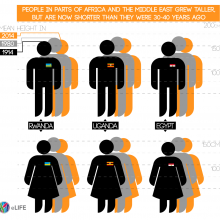
00:31 - Tall story
Tall story
with James Bentham and Majid Ezzati, Imperial College

James - So the tallest people were in Scandinavia, they were in the USA, Canada, Australia, and so on, and also some Pacific Islands. The shortest people were in parts of Central America, they were in the Middle East, in Southeast Asia. The average height of men was around 5'7" in the tallest countries; the average height of women was much shorter.
Kat - And now, how has that changed - again where are the tallies and where are the shorties and how much have they grown?
James - The tallest people now are in Europe, so the top ten countries for both men and women are European countries. On the other hand, the countries that have grown are spread round the world. So the countries that have grown the most are in East Asia, so Japan and South Korea have grown particularly dramatically. Iranian men are much taller and then there's been a lot of growth in southern Europe as well.
Kat - So this hasn't been across the board - the whole world is getting taller. There are unevennesses?
James - There are big unevennesses, yes. So every country in the world has grown taller but some have only grown taller by a matter of a centimetre or so. Whereas other countries, for example, women in South Korea are 8" taller than they were.
Kat - Wow! I wish I could be 8" taller. And are there any countries that are actually getting smaller?
James - There are countries that are smaller than they were 30 years ago, or 40 years or so.
Kat - So they had a peak and now they're getting shorter again?
James - Yes, particularly in Sub-Saharan Africa - we see this in various countries there. They reached a peak and since then their height has declined by 5-10 centimetres.
Kat - So Majid, we've heard how the data has changed - how these trends have changed. How some countries have got taller and then plateaued, some countries are getting much taller and some have got taller and then dropped off. What's behind these patterns of changes?
Majid - We do know from decades of work in nutrition and physiology that height is really a matter of nutrition, environment and the care that they get. And in some sense, the changes, the improvements and the variations reflect better and worse social, nutritional, and environmental conditions during pregnancy, in early childhood and adolescence, and they reflect that accumulation of that advantage versus adversity.
Kat - As a geneticist I know there's a certain proportion of height that is in the genes and a certain proportion that's to do with the environment. How does that balance out in different countries - do we think that maybe some countries have better height genes than others?
Majid - Sure. If we take a snapshot at one moment in one population, genes are hugely important and, again, some of the best studies seem to show that 20/30 per cent is due to genes. But genes don't change very fast over time, it's really environment and it's really nutrition. While there may be variations in genes between different countries, the belief is that its role is much smaller than differences in environment and nutrition.
Kat - So if it does mostly boil down to nutrition, what kind of foods are important?
Majid - So we should remember that nutrition isn't just about food. It's about the conditions in which the foetus grows, so the mother having a good environment and good nutrition, and it's about maintaining nutrition. Food does matter and animal products, animal protein, and dairy are quite helpful for growing taller. They include the components and nutrients that help with growth but it should also be the case that those nutrients are maintained. So a child that lives in a home that doesn't have clean water and actually gets repeated episodes of diarrhoea, they lose any nutrition that they would be getting. Or a child that doesn't have ready and high quality access to healthcare so that they are treated when they get an infection, when they have an illness, those things matter.
Kat - Why is it important? Obviously it's very interesting from a data-nerdery point of view to look at height and see how things have changed and we can draw some cool graphs, but why does height matter? What does it reflect?
Majid - Greater height is associated with longer longevity and better education and economic performance. So it's really the connection between early life conditions and later life health. For that reason it says a lot about how society thinks about its future.
Kat - So James, just one final question. I am 5' tall (about 152cms). Where in history would I have been tall?
James - In 1914, you would have been tall in Guatemala because the average height of Guatemalan women then was 4' 7", and you'd still be taller than average there because the average height was 4' 11".
Kat - So basically, I need to move to Guatemala?
James - Yes! Essentially that's the answer.
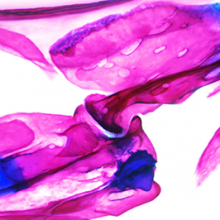
05:48 - Joint secrets
Joint secrets
with Gage Crump, University of Southern California
Gage - For a long time, it was thought that when animals came on the land, they had these new mechanical forces walking around in response to gravity and that drove these really special types of lubricated joints which are the type of joints that go wrong in arthritis. And so, we want to understand well – is it really true that these lubricated joints are just in land animals or could they be much more ancient? Surprisingly, there is very little previously known about when lubricated joints first came around. So we used zebrafish which is a model organism for vertebrate biology to really interrogate whether they also have similar lubricated joints to the type that we do.
Chris - And you're telling me no one has actually really studied this in detail despite the enormity of the question.
Gage - Yeah. It was actually very surprising. Several years ago, starting this project, I would Google ‘evolution of lubricated joints’ and I could find almost nothing. There was one study in 1942 by a scientist named Hanes but that was in the premolecular era and a lot of these old papers have really been lost to a lot of modern scientists.
Chris - So how can you use genetics to probe this then?
Gage - Zebrafish is a great system especially with gene editing now where we can very simply go and knockout any gene we want very easily. And so, what we did is we focused on this protein called lubricin because it actually functions as a kind of an oil for joints. It’s known that both in people or mice that lack this protein, joints wear very quickly and they get early onset arthritis. So we figured, if we get rid of this in zebrafish and their joints also degenerate very early, that would make a strong argument that the zebrafish joints are lubricated because they need this lubricant protein.
Chris - And that’s what you did is that you went in there and used genome editing tools to get rid of the lubricin gene from the zebrafish.
Gage - Yeah, exactly. So the first thing we need to do is actually show that this lubricin protein – this lubricant – was actually made at fish joints. We did that by looking at not only zebrafish but also a couple of other fish. We then removed the gene from the zebrafish genome and it was really spectacular when we saw the phenotype because it looked almost identical to what you see in mice or people lacking this gene.
Chris - Now obviously, we have a very different set of joints than our fish ancestors do, so what joints were you looking at in the fish?
Gage - Initially, we were looking at the jaw joint. The reason for that is that it’s thought to be one of the most ancient joints in all of animals. And so really, the first fish that evolved were thought to have biting jaws before they had arms, legs, or even fins. And so, we had started with the jaw joint, but then we found later that there's actually these very small joints at the base of the fins in fish which also require this lubricant protein. And it turns out that these really tiny bones at the base of the fin are really what became the arms and legs of land animals with limbs.
Chris - Is the pathology that the zebrafish lacking the gene develop – is that the same as the mice that you knocked this gene out from? Do they get the same sort of joint damage?
Gage - Yeah. That was actually what was most remarkable to us. There was a set of cellular changes that really characterised loss of this gene which is different from other syndrome. And so, what you get is all these cells dying at the joint surface, this material sloughing off. But then you also have these underlying cartilage cells that divide too rapidly and build up a process called hyperplasia. And really, we saw this whole spectrum of phenotypic changes that you would see in a mouse or human also lacking that gene. So it’s remarkable conservation of the pathology that surprised even us.
Chris - So what you're saying here, is that historically it’s quite a nice compelling story that lifting themselves out of water forced fish and those descendants to develop the sorts of synovial joints that we haven't take for granted today. But in fact, they were already there well before those animals decided to get out of water.
Gage - Yeah. We think it makes sense because if you’ve ever gone swimming, you know that it’s very hard to move your arms and legs in the water. there's a lot of pressure from the water. so, it’s a different type of force than the gravity when you're walking but it’s also a significant force. If you imagine these very early fish, they're constantly snapping their jaws on prey. There's going to be a lot of compressive forces on their joints that could cause them to wear down every time. so actually, if you step back and think about it, it makes sense that these early fishes would have these lubricated synovial program in their jaw joint even before that was then used again in limbs when animals came on the land.
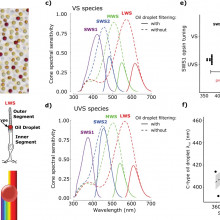
11:19 - Seeing things clearly
Seeing things clearly
with Matthew Toomey, Washington University, St Louis
Matthew - Birds are exceptionally visual organisms and their visual systems are much more complex than the human visual system at least at the level of the eye. We humans, our colour vision system relies on three different cone photoreceptors. So, these are light sensitive cells that are sensitive to red wavelengths light, green wavelengths of light, and blue wavelengths of light. But birds in comparison use 4 different cone photoreceptors sensitive to red, green, and blue just like humans, but they also have a violet or an ultraviolet sensitive cone photoreceptor that they use for colour vision. Those photoreceptors are also more complex than human photoreceptors. So not only do they have a light sensitive part of the cell. They also, within the cell, have a light filter and they combine that light filter and light sensor together to really finely tune what wavelengths of light the photoreceptor is going to respond to.
Chris - Now, when you say they’ve got a filter in that, why do they need to do that?
Matthew - So, that filter serves as a long pass colour filter so it’s absorbing a lot of the shorter wavelengths of light passing them onto the sensitive part of the cell. That narrows the range of wavelengths that a given cell will respond to. It will reduce overlap in sensitivity with the other colour-sensitive cells.
Chris - So it gives them the ability to discriminate colours more acutely than we can. Has it always been like that?
Matthew - So, one of the major divisions among bird species or biggest differences in their visual system is that some bird species are sensitive to violet light – that fourth cone is sensitive to violet light – and in other species, that cone is sensitive to ultraviolet light. This seems to be a switch that’s happened several times throughout the evolution of birds. What we also see in these species as they switch from violet to ultraviolet sensitivity is that they change the sensitivity of the accompanying photoreceptors. So the blue sensitive cell in particular kind of moves over to track that violet/ultraviolet shift. What we were trying to get at with our work or trying to better understand is, how they made that shift in the filtering pigment within the blue.
Chris - Do you think that those changes occurred almost synchronously or did the birds have to suffer not such good colour discrimination for a while while they then re-evolve the ability to retune the other photoreceptors to give them that better discrimination?
Matthew - That’s a good question. We don’t actually know the sequence of events at this point, but the switch between violet and ultraviolet sensitivity is relatively easy to make. It’s just one small change in the gene for that light sensitive part of the cell whereas to shift the filtering of the oil droplet, it’s a change in a pathway that metabolises the pigments that are the filter in the blue cone so it’s a bit more complicated to shift the blue cone. So, it may be the case that first, we get a shift in the violet to ultraviolet and then the accompanying changes happen in the other cell type.
Chris - Now excuse this terrible pun, but how did you then shed light on how this was achieved?
Matthew - What we did was make very detailed measurements of the light absorbent properties of those filtering pigments in the blue cone and accompany that by chemical characterisation of the pigments that are in that cone. We determined that the shift in the filtering of the cone is the result of a change in the chemical composition of that filter. So, they're actually just eliminating a single double bond in the pigment molecule that’s in that filtering pigment. So, it’s a very small change in chemical structure, yields a rather dramatic shift in the light absorbing properties of that filter.
Chris - Now you’ve sussed out how this happens, what are the implications of this? How does this sort of change our thinking of bird vision?
Matthew - What our study have shown is that evolution of ultraviolet vision in birds involves not only a change in that one photoreceptor – violet cone shifting to ultraviolet sensitivity but also, a whole suite of other adaptations are occurring within the eye to optimise vision for this new expanded sensitivity. That’s what I think is really exciting is these very different mechanisms in different cell types, different tissue types, with different biochemical properties and physiological properties are all coordinated towards a common outcome that we can understand in terms of facilitating the discrimination of colour.
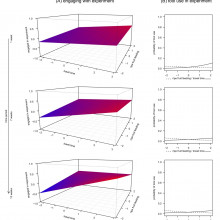
Making the effort
with Thibaud Gruber, University of Geneva
Thibaud -The experiment is called “honey-trap experiment”. The idea is you have a log and in the log, we’re drilling a hole. Inside this hole, we put some honey. The catch is that the honey is too deep to be reached by your hands. And so, the chimpanzees who encounter the experiment have to find a way to get it.
Chris - So, what sorts of tool do they need to fashion to retrieve the honey?
Thibaud - Well, it actually depends on the chimpanzee community cultural background because I ran this experiment in several communities in what I would say a controlled community. So that was in Kibale forest. The chimps, they used sticks to get the honey. But the other community where I have been working which is actually the focus in this study is the Sonso community of Budongo forest. These chimps, they don’t know how to use sticks. So, what they actually did for – so 10 chimps out of the 50 we tested, they actually use leaf sponges. Basically, they take some leaves from the vegetation, they roll them in their mouth and then they use this to get the honey.
Chris - What was the variation that was occurring in the experiment that you were seeking to test here?
Thibaud - Basically, there were two kinds of variation that we could study. The first one was how much time chimpanzees are going to spend trying to access the honey. Sometimes we would have chimps who would just engage with the experiment for like 2 seconds and then just leave. And other times, we had chimps who would spend 20 minutes. This was one of the first things we wanted to test. The second variation was only a few occurrences of tool use. So that means most chimps actually never managed to get the honey. So, what would actually make you use a tool?
Chris - How did you actually assess this? What was the method of processing these findings?
Thibaud - To do that, it’s very great benefit of working in a long term field site because we have a lot of information about the individuals and it is also a very well organised system to collect data about the behaviour of each individuals. What we have is a database of behaviour. What we did was extract the behaviour of the individuals who had been engaging with the experiments. So basically, if you imagine that our chimps- one chimp called Night would engage with the experiment on the first of January then we could go back in the data, look at what he was doing in December and November before engaging with the experiment because we wanted to know how much she was traveling, what she had been feeding on and try to see this has an influence on engagement with the experiment.
Chris - I wondered if that was the direction you were going to take this and you were going to argue that what was basically driving it is whether or not the animals are really hungry and therefore motivated to want to get to that honey because honey is quite a rewarding thing to find for them if they're hungry.
Thibaud - We don’t know actually if honey is nice treat or something that’s really a good thing to consume just to level out your energy. There has been like some conflicting result. I don’t know if it’s really about being hungry or not. What we found was, they would engage most of the experiment when they really had a bad period. They had been traveling a lot, they did not eat a lot of fruits which is normally their favourite food in the forest. When this happened then they were engaging a lot. So that would really suggest that they would really engage with the experiment out of necessity.
Chris - When you say engage with the experiment, did that mean that they spent longer fiddling with the log because they wanted to get the honey out or was there also a difference in whether or not they resorted to tool use in that setting?
Thibaud - We found two main results. So, for the engagement, what we found was a kind of long term effect. So there was basically a combination of not eating your favourite food much and having to travel a lot to find it, would basically build up some oversetting of engaging with the experiment and that was even more pronounced if the situation had been quite bad for a long time. For tool use, what was interesting is that we didn’t actually find an effect of what they were feeding on although it was kind of suggestive of it. But the really main big effect that we found was how much was travelled in the week preceding the experiment. Somehow the tool use seems to be more driven by an immediate need. Maybe it’s because it’s more costly and that drives you to think – I don’t know – maybe more creatively. It was really connected to the probability of using a tool.
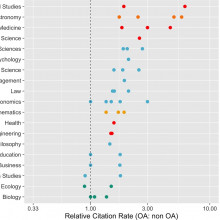
22:13 - In the open
In the open
with Erin McKiernan, National Autonomous University of Mexico, Mexico City
Erin - One thing that you're very worried about as a scientist is whether people are reading your work and then referring to it on their own work, siting it. There are a lot of studies that show that if your work is published in some type of open platform, whether it be repository that’s open to the public, or a journal that’s open to the public, then that work tends to get cited more often than work that’s published in a closed platform. That intuitively makes sense. If more people can read your work, more people can understand what you did and the results of your study then they're going to be more likely to cite it and refer to it in their own work.
Chris - What about the question though that people do view certain journals as top tier and they aspire to publish a paper in those journals? They're not necessarily Open Access. How do you persuade them that they shouldn’t do that? They should publish their paper somewhere open access instead?
Erin - I don’t think we necessarily need to persuade them to move away from those closed venues entirely. Part of the problem is that the incentive structure is such that we are still giving people lots of points so to speak in evaluations for publishing in those high profile, high visibility journals like Nature and Science. What we can tell them instead is there are many different ways to show your work. publishing in a journal that’s open for everyone to read, an open access journal is just one way. Another way is to publish in the journal of your choice and then you can take a copy of your article and post that separately on an open platform. Most of those journals do allow researchers to do that. So, even though the article in the original journal is not open to everybody, there is a version online that other people can access. And that way, we give researchers options. We tell them, “Yes, we understand that this is something that you need to do to advance your career. That’s okay, as long as you put a version somewhere that people can read.”
Chris - The other thing that I think does bear on the research community’s collective mind, they actually really relish the objective measure – if you can call it objective – of the impact factor. When you have nascent journals – eLife is a good example of this which haven't been going very long – it’s very hard to have a similar metric to offer a scientist because most people, when I talk to them about this, “Well, I won't publish in certain places because there's no impact factor or there won't ever be one.”
Erin - Yeah, this reliance on impact factor has really been damaging to both scientists individually and I think science in general, you put that incentive for people to publish in those high impact factor journals. That’s where they're going to publish or try to publish. In fact, sometimes they may even change the type of study they're doing to try to get into those journals. That’s when we should be really worried because now, it’s driving the science that we’re doing. I think we all agree that that type of incentive shouldn’t be the driving factor for what type of science we’re doing. So, I think again, that’s something that we have to change at an incentive level. So there is a movement for example, the San Francisco Declaration on Research Assessment – is a statement signed by both individuals and organisations all over the world saying that we recognise that impact factor is not a good metric. It doesn’t speak to the quality of science that we’re doing, and that it should never be used as an evaluation metric.
Chris - If I approach the Chief Executive of the publishing houses, of places like Nature, Elsevier and so on, who do paid-for journal subscriptions, they will argue that they charge a very fair price because they bring enormous editorial skills to the table and their distribution network, and so on, and these all costs money. They have to recoup their costs by selling that copy back to the community. So, how do we make sure that Open Access doesn’t suffer a loss of quality because there isn’t the same financial model there to support it.
Erin - I think Nature is a special case because they do provide a lot of editorial support that some other journals don’t supply and still charge a high price. So, at that point we have to ask, what are those journals doing that’s really justifying the price of their charging? I think it’s important that if the journals want to make that argument, that they should be transparent with those numbers. I would love to see how the numbers breakdown for lots of different journals in terms of the services that they're providing for the money that they charge. It is a concern what type of business model we have going forward because right now, a lot of the Open Access journals, to cover those costs, they charge a fee to the author to publish their article – article processing charges and those APCs can be very high. That’s a price that’s out of reach for a lot of scientists especially scientists in developing countries. And so, I think we have to look for different models. Latin America has been revolutionary in this space, so they have a couple of different platforms – one called SciELO, another called Redalyc – where they publish thousands of journals that are not only free for the author to publish it but also free for the public to read. A lot of those journals are supported by university consortiums and other types of funding like that.
Chris - When you put your case to early career scientists who were the ones that you're most eager to insure have confidence in the Open Access movement, what sort of reaction are you getting. Are we seeing a regime change or are people beginning to favour this concept?
Erin - I'm not sure. I wish I had an idea of how widely accepted it is. It’s very easy sometimes in the Twitter space, in the Facebook space to get in the neck or chamber where you're with people who are like-minded. So you end up thinking that these views are very widely held. In fact, I think that there's still a huge percentage of scientists who first of all don’t even know about some of these issues. They work in wealthy universities that are able to pay the costs of access to these journals. They don’t realise that access is a problem for a lot of people. So, I think that we still have a lot of work to do, but I think that we’re also seeing good momentum. And so, I think that’s a very positive sign.
- Previous Scrutinizing Science
- Next See-through rats bare their brains










Comments
Add a comment